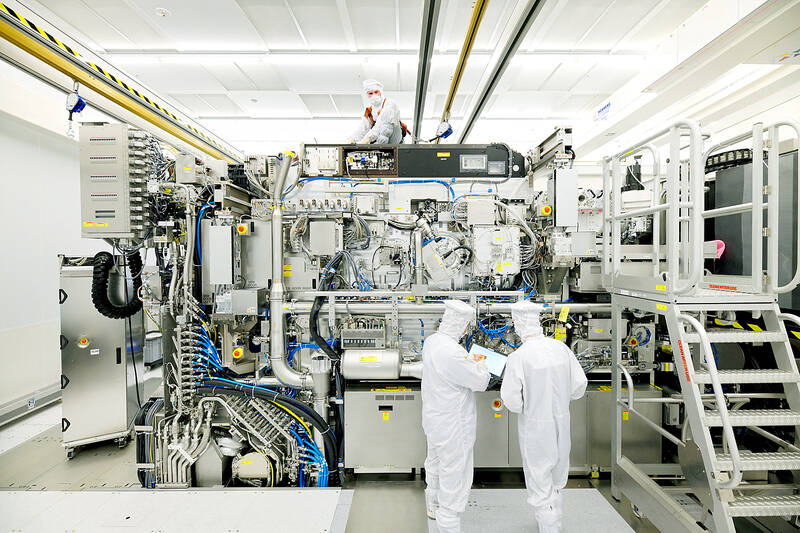Taiwan was the top spender on semiconductor equipment in the first quarter of this year, global semiconductor trade association SEMI said on Wednesday.
Taiwan spent US$6.93 billion on semiconductor equipment during the period, up 42 percent from a year earlier, but down 13 percent from the previous quarter, SEMI data showed.
The association represents companies in the electronic manufacturing and design supply chain.

Photo: Reuters
China was the second-biggest spender with US$5.86 billion, down 23 percent from a year earlier and 8 percent from last quarter, the data showed.
South Korea came in third with US$5.62 billion, up 9 percent from last year, but down 3 percent from a quarter earlier.
North America was the fourth-largest market with spending of US$3.93 billion, rising 50 percent from a year earlier and 51 percent from a quarter earlier, making it the fastest-growing market in the world, SEMI said.
Japan took fifth place after spending US$1.9 billion on semiconductor equipment, little changed annually, but falling 16 percent quarterly.
Europe ranked sixth with spending of US$1.52 billion, up 19 percent from a year earlier and 4 percent from a quarter earlier.
In the first quarter, total semiconductor equipment spending worldwide totaled US$26.8 billion, up 9 percent from a year earlier, but down 3 percent from a quarter earlier, the data showed.
Semiconductor spending remained solid, even though the global economy was facing significant challenges, SEMI said, adding that emerging applications such as artificial intelligence continued to grow, paving the way for the long-term growth of the IC industry.
Last year, global semiconductor equipment spending totaled US$107.6 billion, up 5 percent from a year earlier. China was the largest buyer with US$28.27 billion of spending, down 5 percent from a year earlier.
Taiwan ranked second with US$26.82 billion of spending, up 8 percent from a year earlier.
South Korea followed with US$21.51 billion, down 14 percent from a year earlier.

The US dollar was trading at NT$29.7 at 10am today on the Taipei Foreign Exchange, as the New Taiwan dollar gained NT$1.364 from the previous close last week. The NT dollar continued to rise today, after surging 3.07 percent on Friday. After opening at NT$30.91, the NT dollar gained more than NT$1 in just 15 minutes, briefly passing the NT$30 mark. Before the US Department of the Treasury's semi-annual currency report came out, expectations that the NT dollar would keep rising were already building. The NT dollar on Friday closed at NT$31.064, up by NT$0.953 — a 3.07 percent single-day gain. Today,

‘SHORT TERM’: The local currency would likely remain strong in the near term, driven by anticipated US trade pressure, capital inflows and expectations of a US Fed rate cut The US dollar is expected to fall below NT$30 in the near term, as traders anticipate increased pressure from Washington for Taiwan to allow the New Taiwan dollar to appreciate, Cathay United Bank (國泰世華銀行) chief economist Lin Chi-chao (林啟超) said. Following a sharp drop in the greenback against the NT dollar on Friday, Lin told the Central News Agency that the local currency is likely to remain strong in the short term, driven in part by market psychology surrounding anticipated US policy pressure. On Friday, the US dollar fell NT$0.953, or 3.07 percent, closing at NT$31.064 — its lowest level since Jan.

Hong Kong authorities ramped up sales of the local dollar as the greenback’s slide threatened the foreign-exchange peg. The Hong Kong Monetary Authority (HKMA) sold a record HK$60.5 billion (US$7.8 billion) of the city’s currency, according to an alert sent on its Bloomberg page yesterday in Asia, after it tested the upper end of its trading band. That added to the HK$56.1 billion of sales versus the greenback since Friday. The rapid intervention signals efforts from the city’s authorities to limit the local currency’s moves within its HK$7.75 to HK$7.85 per US dollar trading band. Heavy sales of the local dollar by

The Financial Supervisory Commission (FSC) yesterday met with some of the nation’s largest insurance companies as a skyrocketing New Taiwan dollar piles pressure on their hundreds of billions of dollars in US bond investments. The commission has asked some life insurance firms, among the biggest Asian holders of US debt, to discuss how the rapidly strengthening NT dollar has impacted their operations, people familiar with the matter said. The meeting took place as the NT dollar jumped as much as 5 percent yesterday, its biggest intraday gain in more than three decades. The local currency surged as exporters rushed to